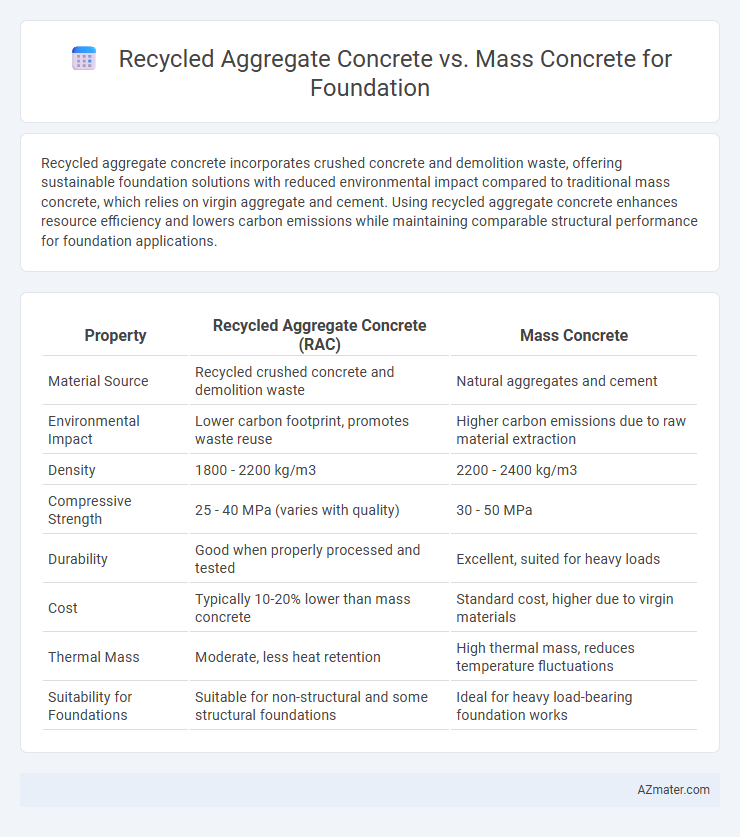Recycled aggregate concrete incorporates crushed concrete and demolition waste, offering sustainable foundation solutions with reduced environmental impact compared to traditional mass concrete, which relies on virgin aggregate and cement. Using recycled aggregate concrete enhances resource efficiency and lowers carbon emissions while maintaining comparable structural performance for foundation applications.
Table of Comparison
| Property | Recycled Aggregate Concrete (RAC) | Mass Concrete |
|---|---|---|
| Material Source | Recycled crushed concrete and demolition waste | Natural aggregates and cement |
| Environmental Impact | Lower carbon footprint, promotes waste reuse | Higher carbon emissions due to raw material extraction |
| Density | 1800 - 2200 kg/m3 | 2200 - 2400 kg/m3 |
| Compressive Strength | 25 - 40 MPa (varies with quality) | 30 - 50 MPa |
| Durability | Good when properly processed and tested | Excellent, suited for heavy loads |
| Cost | Typically 10-20% lower than mass concrete | Standard cost, higher due to virgin materials |
| Thermal Mass | Moderate, less heat retention | High thermal mass, reduces temperature fluctuations |
| Suitability for Foundations | Suitable for non-structural and some structural foundations | Ideal for heavy load-bearing foundation works |
Introduction to Foundation Concrete Types
Recycled aggregate concrete incorporates processed construction waste materials, offering improved sustainability and reduced environmental impact compared to traditional mass concrete, which relies on virgin aggregates and is known for its high volume and density. Foundation concrete types vary primarily by the materials used and intended structural performance, with mass concrete suited for heavy load-bearing applications due to its thermal stability and minimal reinforcement requirements. Choosing between recycled aggregate concrete and mass concrete depends on project-specific factors such as environmental regulations, load demands, and cost-efficiency.
Understanding Recycled Aggregate Concrete
Recycled aggregate concrete (RAC) utilizes crushed concrete waste as a replacement for natural aggregates, promoting sustainability and reducing landfill demand in foundation construction. This material exhibits comparable compressive strength and durability to conventional mass concrete when properly processed and mixed, making it a viable option for structural footing and foundation applications. Incorporating recycled aggregates enhances resource efficiency and minimizes environmental impact without compromising the load-bearing capacity essential for foundation stability.
Overview of Mass Concrete Foundations
Mass concrete foundations are large, solid structures designed to support heavy loads and resist environmental stresses through their sheer volume and density. They rely on the thermal properties of the concrete to control temperature differentials, minimizing the risk of cracking during curing. Compared to recycled aggregate concrete, mass concrete emphasizes durability and structural integrity, often using conventional aggregates for optimal strength and stability in foundational applications.
Material Properties Comparison
Recycled aggregate concrete (RAC) typically exhibits lower density and compressive strength compared to mass concrete due to the presence of porous old concrete particles. Mass concrete, composed of natural aggregates and higher cement content, offers superior durability, lower permeability, and enhanced structural integrity for foundation applications. Both materials require careful consideration of thermal properties and shrinkage behavior to minimize cracking risks in foundation structures.
Structural Performance Differences
Recycled aggregate concrete (RAC) exhibits lower compressive strength and increased porosity compared to mass concrete, impacting its load-bearing capacity and durability in foundation applications. Mass concrete, composed of natural aggregates, typically provides superior structural integrity and reduced shrinkage, making it more suitable for heavy load conditions. The use of RAC in foundations requires careful mix design and quality control to mitigate weaknesses and ensure adequate performance in structural stability and longevity.
Environmental Impact Analysis
Recycled aggregate concrete significantly reduces environmental impact by lowering landfill waste and decreasing the extraction of virgin materials, thus conserving natural resources and reducing carbon emissions associated with aggregate production. Mass concrete, while providing substantial structural strength for large foundations, typically involves high cement content, contributing to increased CO2 emissions during production. Employing recycled aggregate concrete in foundation projects promotes sustainability by minimizing ecological footprints and supporting circular economy practices in construction materials.
Cost and Economic Considerations
Recycled aggregate concrete (RAC) reduces foundation costs by utilizing waste materials, lowering raw material expenses and landfill fees, while mass concrete typically requires higher-grade aggregates and more extensive curing processes, increasing overall expenditure. Economically, RAC supports sustainability incentives and can lead to long-term savings through reduced environmental impact and potential tax benefits. However, mass concrete's established reliability in load-bearing applications may justify its higher upfront costs for critical infrastructure projects.
Durability and Longevity Factors
Recycled aggregate concrete (RAC) demonstrates improved durability when incorporating advanced processing techniques that reduce impurities and optimize particle size distribution, making it a sustainable alternative for foundation applications. Mass concrete, characterized by its large volume and slow cooling rate, ensures long-term structural integrity by minimizing thermal cracking and enhancing resistance to environmental degradation. The longevity of foundations using RAC depends on proper mix design and quality control, while mass concrete offers proven durability through controlled curing and density management.
Construction Practices and Challenges
Recycled aggregate concrete (RAC) for foundations demands careful attention to mix design and quality control due to variable aggregate properties, which can affect strength and durability compared to mass concrete that relies on uniform natural aggregates. Construction practices for RAC require pre-treatment of recycled materials and stricter monitoring of moisture content to prevent shrinkage and cracking, posing challenges in consistent workability and setting times. Mass concrete construction faces different challenges such as thermal cracking from heat of hydration, necessitating cooling techniques and careful placement to ensure structural integrity.
Suitability for Different Foundation Applications
Recycled aggregate concrete (RAC) offers suitability for non-structural and moderate load-bearing foundations, providing environmental benefits and reducing construction costs by utilizing waste materials. Mass concrete is preferred for heavy load-bearing foundations requiring high compressive strength and durability, such as bridge abutments and large retaining walls, due to its dense, homogeneous composition and controlled heat of hydration. Selection depends on the foundation's load requirements, environmental considerations, and structural performance criteria, making RAC ideal for sustainable projects and mass concrete essential for critical, high-stress applications.

Infographic: Recycled aggregate concrete vs Mass concrete for Foundation
 azmater.com
azmater.com